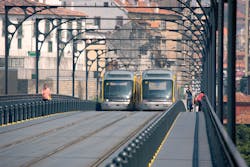MA: Porto LRT, Receives Award for Sustainable Urban Planning from Harvard University
The Porto Light Rail Train (LRT) has been awarded the Veronica Rudge Green Prize, granted every two years by the School of Design at Harvard University to projects that stand out for their excellence in sustainable urban planning.
The engineering and technology group Sener has been one of the key players in this project, since it has been involved in all phases of the metro network development process as the company responsible for services ranging from technical assistance to its construction and commissioning.
Sener led the Ensitrans joint venture, in charge for the direction of the technical assistance provided to the company Metro do Porto, S.A. Therefore, Sener was one of the key project partners, as it carried out tasks from the preparation of the preliminary studies to the election of the system, the drafting of the basic project and the technical specifications sheet, the evaluation of contractors' offers and the subsequent negotiation with the shortlisted firms, the monitoring and review of the construction projects, the project management, the tunnel construction and, finally, the commissioning of the line; it also advised Metro do Porto, S.A. in matters related to the system certification process.
In addition, between 2006 and 2010, Sener also participated in the monitoring of the operation and maintenance of the entire metro network operated by the consortium Normetro and was awarded the contract to develop the technical assistance for the second construction phase of this metro project. This latter work has included the review of the construction projects and the launch of bids (for both project and execution of works) as well as the supervision of the execution of civil engineering works, the fixed equipment and the operation and maintenance.
Porto LRT, in operation since 2002, links seven municipalities of the Porto Metropolitan Area, has connections with the major bus and rail networks and reaches also Pedras Rubras international airport. Annually, it moves about 55 million passengers in its four lines, with a total length of seventy kilometers including 63 surface stations and 14 underground stations. The network combines sections on surface, with tracks over shared or segregated platforms, and underground sections, having seven kilometers of tunnels.
From the outset, the system was designed with the aim to become a factor of urban renewal and regeneration. For this reason, its contribution to the preservation of Porto, a city that is included in UNESCO’S list of World Heritage, has been highlighted, being also noteworthy its contribution to the improvement in the conditions of life of its inhabitants as well as in the integration of isolated areas.
In this sense, Sener’s team of architects and city planners designed the urban implementation of the LRT lines all along their length, determined the alignment and position of platforms and stations. They specified also the criteria to be followed in future extensions of the system.
The quality of the project has been recognized previously; in particular, in June 2008, the system received from the International Association of Public Transport (UITP) the Light Rail Award - Best New System, which distinguishes the creativity and design of light rail systems around the world.
